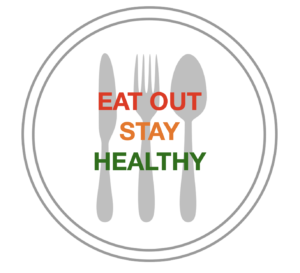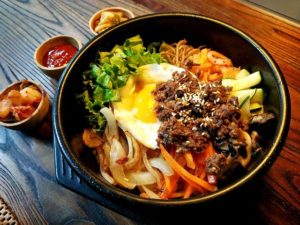“The most important thing you can do, and it’s challenging for many people, is cook for your family.”
Unfortunately, cooking at home with REAL ingredients is becoming less common and each generation seems to be losing the skills and confidence to prepare delicious meals in the kitchen. In fact, just in the past couple years, spending on food away from home has now exceeded food purchased at grocery stores.
As you can imagine, we are huge advocates of eating home-cooked meals whenever possible. But, realistically, we know there are occasions where you find yourself needing to eating out, whether it be for a social or business gathering, or for the convenience of a meal away from home. And, with so much food now being purchased and consumed away from home, we want to provide some tips on how to enjoy REAL food and stay healthy when eating out. Of course, there is the obvious advice like avoid “all-you-can-eat” buffets and stay away from fried foods, but we want to provide some other, hopefully useful, insights.
The good news?
Better and healthier options seem to pop up all the time!
The bad news?
There are still A LOT of traps out there…menu items loaded with sodium, added sugars, too much of the wrong types of fats and many other additives and preservatives.
What are things to look out for?
 Beware of sauces and dressings! This is where you find a lot of sodium, added sugars, unhealthy fats and other highly processed ingredients. Stay away from words like creamy, cheesy, smothered and alfredo. For salad dressing, you can ask for oil and vinegar to deliciously dress your salad. Vinaigrettes are often good options, but it’s worth asking how they are prepared. Fresh salsa can also be a fantastic salad dressing (or topping for a baked potato). If you are eating pasta, try to find a simple tomato-based or olive oil-based sauce. For sandwiches, opt for mustard instead of mayo or aioli. Dishes flavored with herbs and spices are typically better than those covered with dressings, gravies or sauces.
Beware of sauces and dressings! This is where you find a lot of sodium, added sugars, unhealthy fats and other highly processed ingredients. Stay away from words like creamy, cheesy, smothered and alfredo. For salad dressing, you can ask for oil and vinegar to deliciously dress your salad. Vinaigrettes are often good options, but it’s worth asking how they are prepared. Fresh salsa can also be a fantastic salad dressing (or topping for a baked potato). If you are eating pasta, try to find a simple tomato-based or olive oil-based sauce. For sandwiches, opt for mustard instead of mayo or aioli. Dishes flavored with herbs and spices are typically better than those covered with dressings, gravies or sauces.
- Some menu items sound healthier than they really are. For example, P.F. Chang’s Mandarin Crunch Salad is described as “julienned vegetables, chopped cabbage, mango, almonds, crispy rice sticks, mandarin vinaigrette.” Sounds healthy, right?! Well, it weighs in with 2,300 mg sodium and 52 grams (yes, that’s 13 tsp) of sugar. Their Sesame Chicken is described as “sesame sauce, broccoli, bell peppers, onion.” So, chicken and veggies…must be healthy! Would you believe 2,410 mg sodium and 83 grams (over 20 tsp) of sugar?!
- The menu can often be altered. While demand for healthier options is increasing, many restaurant menus are still targeted at customers wanting dishes that are deep fried, smothered in cheese or drowned in butter. Most restaurants will provide alternative preparations if you ask (e.g., grilled or roasted instead of fried, no cheese, a little olive oil instead of butter, steamed rice instead of fried rice).
- Use caution with “free” food. Most of the biscuits, rolls, chips and breads that come “free” to the table before the meal are unhealthy, highly-processed, not to mention addicting, and it’s incredibly easy to overindulge.
- Want dessert? Save room for dessert by cutting back on items like bread, rice, potatoes or drinks. Or, satisfy a sweet craving after your meal with a piece of fruit or dark chocolate. This is also the perfect opportunity to share or take home half!
Don’t stress out — there are things you can do:
- Be choosy! Whenever possible, choose restaurants with good options. Restaurants that focus on in-season and local ingredients are likely to have some great options. Also, Middle Eastern, Mediterranean, Greek, Japanese and Indian restaurants often have options with veggies, whole grains, lean meats and healthy fats. Panera, Jason’s Deli and Chipotle are a few chain restaurants that provide some good options.
- Do your homework. Many restaurants now provide online menus and nutrition information. Giving some thought to what you want to order ahead of time can help prevent giving into temptation when everyone is placing their orders.
 Order first! If eating out with friends or colleagues, be the one to order first! You might positively influence others’ choices, and it will be so much easier to make a good choice instead of ordering after everyone else just ordered their stuffed-crust pizza, BBQ bacon burgers, fries and three-cheese lasagna. Then, no regrets! Set aside any momentary feelings of regret for not indulging in the less healthy options…when the food comes, you will be thankful.
Order first! If eating out with friends or colleagues, be the one to order first! You might positively influence others’ choices, and it will be so much easier to make a good choice instead of ordering after everyone else just ordered their stuffed-crust pizza, BBQ bacon burgers, fries and three-cheese lasagna. Then, no regrets! Set aside any momentary feelings of regret for not indulging in the less healthy options…when the food comes, you will be thankful.
- Don’t be afraid to ask! Especially, ask about the ingredients. While nutrition information is sometimes available, we all know it’s the ingredients that tell the story. Don’t be afraid to ask what the ingredients are if you are unsure — your server may have to ask the kitchen, but that’s ok…chances are, the chef will be thrilled someone took enough interest to ask!
- Be mindful. Many restaurants have distractions like 250-inch TVs. And distracted eating leads to large portions and unhealthy choices. Slow down, savor your food, and enjoy the time you are spending with your family and friends! Set a goal to leave the restaurant comfortably full, not over-stuffed and miserable!
- Share! Often, we will share a couple of menu items, one of which is typically an entrée salad. This allows us to experience multiple dishes without overdoing it. Or, portion out half BEFORE you begin eating, and then ask for a “doggie bag” to take the leftovers home for another meal.
 Look for colors and plants! Look around the restaurant and see what kinds of colors are on the plates. Stay away from browns and yellows. Instead, look for vibrant colors like greens, reds and oranges. Salads with the the right (ideally, in-season) ingredients and a simple vinaigrette type of dressing can be healthy and delicious. Also, take a shot at asking for extra veggies…some restaurants will give you a double or triple serving, often without an extra charge.
Look for colors and plants! Look around the restaurant and see what kinds of colors are on the plates. Stay away from browns and yellows. Instead, look for vibrant colors like greens, reds and oranges. Salads with the the right (ideally, in-season) ingredients and a simple vinaigrette type of dressing can be healthy and delicious. Also, take a shot at asking for extra veggies…some restaurants will give you a double or triple serving, often without an extra charge.
- Pay attention to preparation. With meats and seafood, look for dishes that are grilled, steamed or roasted. These will be better options than items that are fried, pan-fried or sautéed (in loads of butter).
- Stay away from sodas and juices. Many of us let our guard down on drinks when eating out. Maybe it’s those huge glasses with unlimited refills. Instead, opt for water or unsweetened tea…not only is this a healthier option, but it will save you a ton of money over the course of a year.
- Focus on what you “get to” eat, not what you “can’t” eat. There’s nothing worse than a meal where you feel like you are depriving yourself. Find something healthy and delicious and get excited about it…you will thank yourself at the end of the meal.
Two final pieces of advice:
Minimize, and ideally avoid, wasted meals.
You know, the meal that provides no flavor or excitement…and you can tell whoever prepared it is just going through the motions to get food on your plate. Life is too short for wasted meals!
Occasionally, throw all rules out the door!
Especially if you have a truly special occasion you are celebrating, find a restaurant where you know the chef puts his or her heart and soul into the menu and the dishes.
These are the memorable meals and, yes, certain dishes may not be the healthiest in the world, but they are worth the occasional splurge!
What are your tips and tricks to enjoying delicious, nutritious food when eating out?
 LEARN MORE ABOUT THE NAPKIN!
LEARN MORE ABOUT THE NAPKIN!




Eating out at restaurants can be fun, but people make the mistake of assuming that it absolutely must be bad for you. Thanks for outlining reasons why this isn’t the case and how eating out can be made healthier.
Thank you – we are glad this coaching tip helped!